Global Economic Landscape: Present and Potential Challenges
VerifiedAdded on 2021/12/09
|7
|1634
|205
Report
AI Summary
This report provides an in-depth analysis of the current global economic landscape, highlighting key challenges and potential solutions. It examines the impact of trade protectionism, the escalating global debt, and the persistent issue of unemployment on international trade and economic growth. The report delves into the volatility of commodity prices, currency fluctuations, and unstable inflation, and their effects on investment and economic stability. It offers recommendations for nations to reduce trade barriers, improve education systems, manage debt effectively, and stabilize currencies and inflation to foster a more robust and sustainable global economy. The report emphasizes the importance of transparency, cooperation, and reform to address these complex issues and promote a more balanced and prosperous world economy. The report concludes that as globalization continues, these challenges must be addressed to avoid decline in the national and world economic growth.
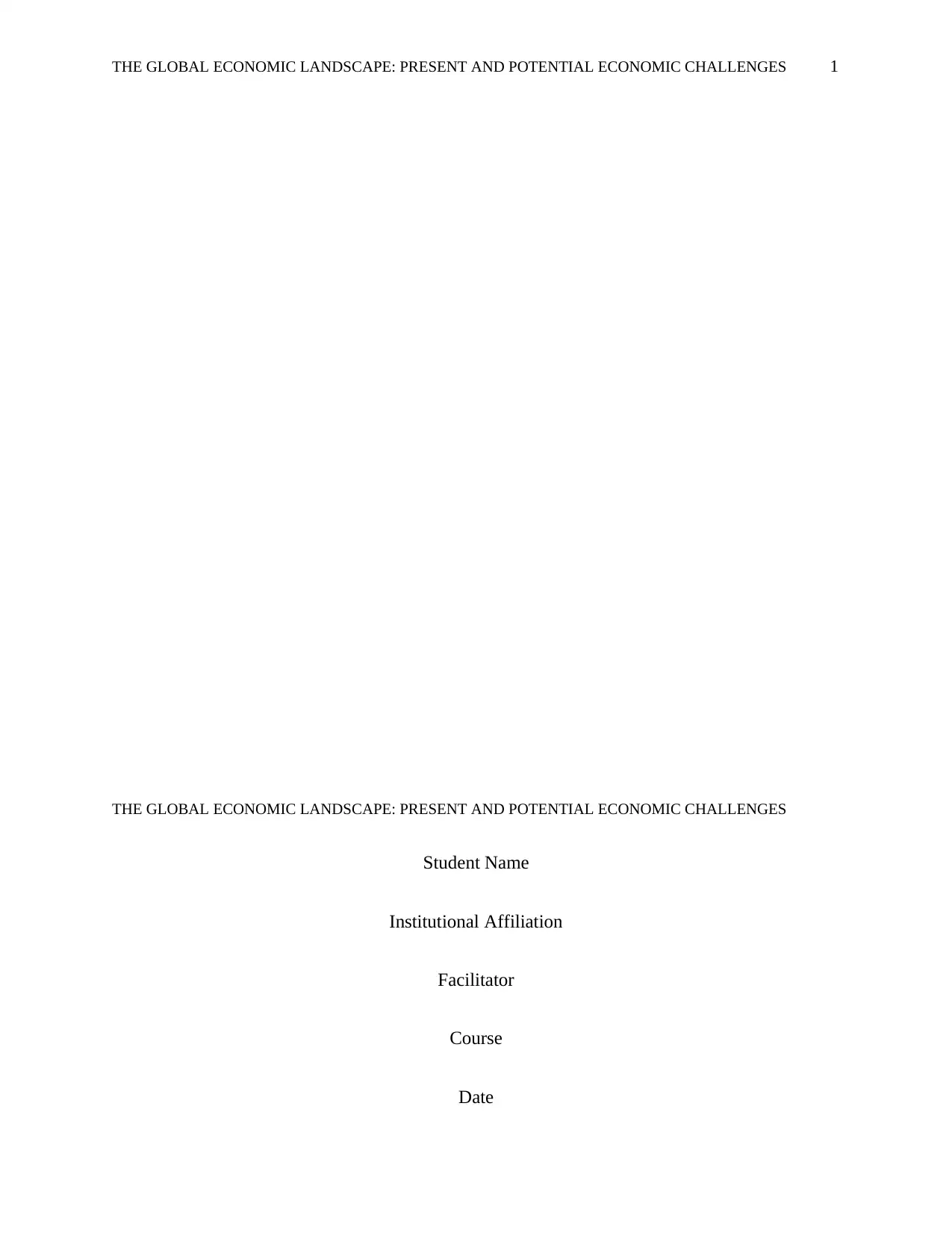
THE GLOBAL ECONOMIC LANDSCAPE: PRESENT AND POTENTIAL ECONOMIC CHALLENGES 1
THE GLOBAL ECONOMIC LANDSCAPE: PRESENT AND POTENTIAL ECONOMIC CHALLENGES
Student Name
Institutional Affiliation
Facilitator
Course
Date
THE GLOBAL ECONOMIC LANDSCAPE: PRESENT AND POTENTIAL ECONOMIC CHALLENGES
Student Name
Institutional Affiliation
Facilitator
Course
Date
Paraphrase This Document
Need a fresh take? Get an instant paraphrase of this document with our AI Paraphraser
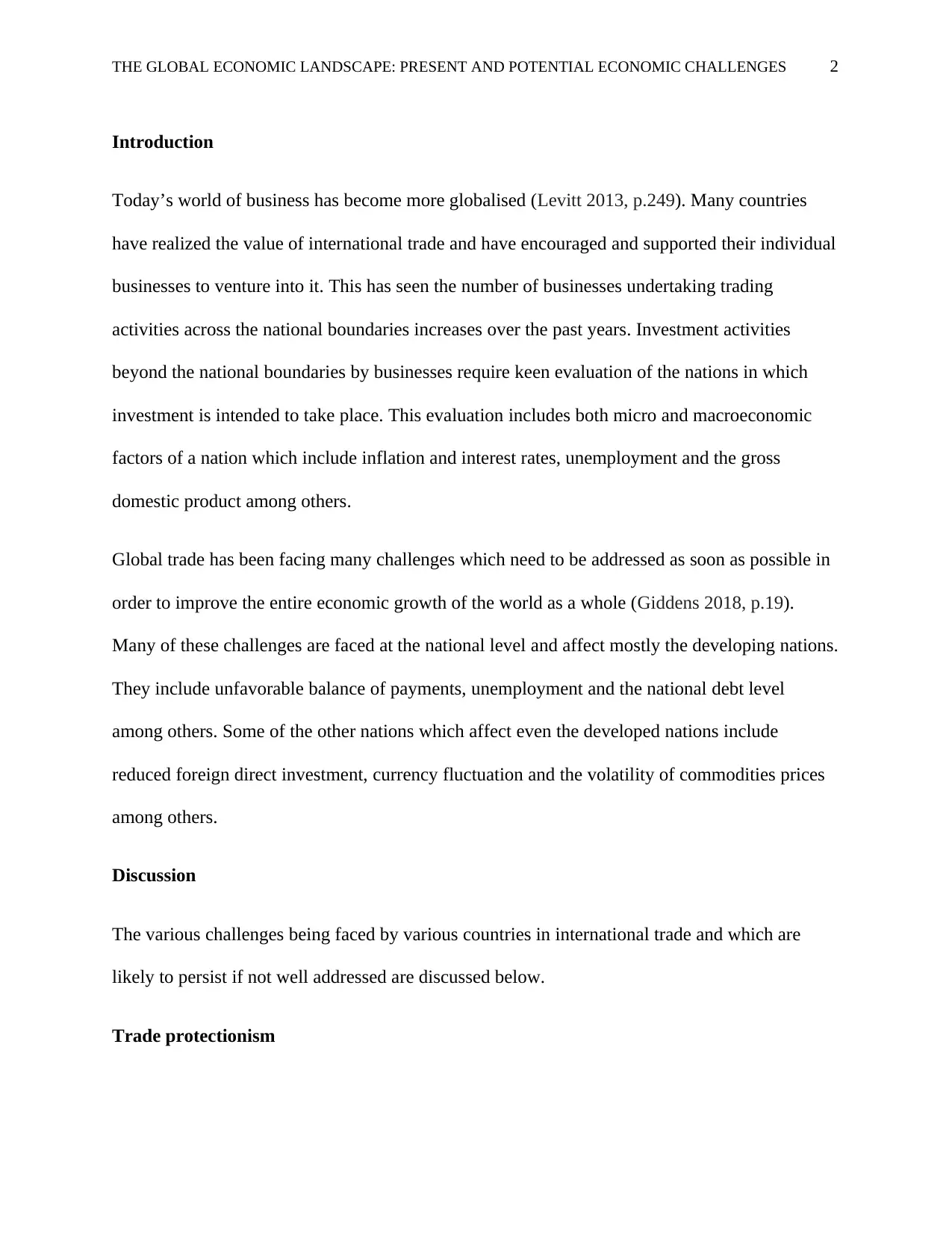
THE GLOBAL ECONOMIC LANDSCAPE: PRESENT AND POTENTIAL ECONOMIC CHALLENGES 2
Introduction
Today’s world of business has become more globalised (Levitt 2013, p.249). Many countries
have realized the value of international trade and have encouraged and supported their individual
businesses to venture into it. This has seen the number of businesses undertaking trading
activities across the national boundaries increases over the past years. Investment activities
beyond the national boundaries by businesses require keen evaluation of the nations in which
investment is intended to take place. This evaluation includes both micro and macroeconomic
factors of a nation which include inflation and interest rates, unemployment and the gross
domestic product among others.
Global trade has been facing many challenges which need to be addressed as soon as possible in
order to improve the entire economic growth of the world as a whole (Giddens 2018, p.19).
Many of these challenges are faced at the national level and affect mostly the developing nations.
They include unfavorable balance of payments, unemployment and the national debt level
among others. Some of the other nations which affect even the developed nations include
reduced foreign direct investment, currency fluctuation and the volatility of commodities prices
among others.
Discussion
The various challenges being faced by various countries in international trade and which are
likely to persist if not well addressed are discussed below.
Trade protectionism
Introduction
Today’s world of business has become more globalised (Levitt 2013, p.249). Many countries
have realized the value of international trade and have encouraged and supported their individual
businesses to venture into it. This has seen the number of businesses undertaking trading
activities across the national boundaries increases over the past years. Investment activities
beyond the national boundaries by businesses require keen evaluation of the nations in which
investment is intended to take place. This evaluation includes both micro and macroeconomic
factors of a nation which include inflation and interest rates, unemployment and the gross
domestic product among others.
Global trade has been facing many challenges which need to be addressed as soon as possible in
order to improve the entire economic growth of the world as a whole (Giddens 2018, p.19).
Many of these challenges are faced at the national level and affect mostly the developing nations.
They include unfavorable balance of payments, unemployment and the national debt level
among others. Some of the other nations which affect even the developed nations include
reduced foreign direct investment, currency fluctuation and the volatility of commodities prices
among others.
Discussion
The various challenges being faced by various countries in international trade and which are
likely to persist if not well addressed are discussed below.
Trade protectionism
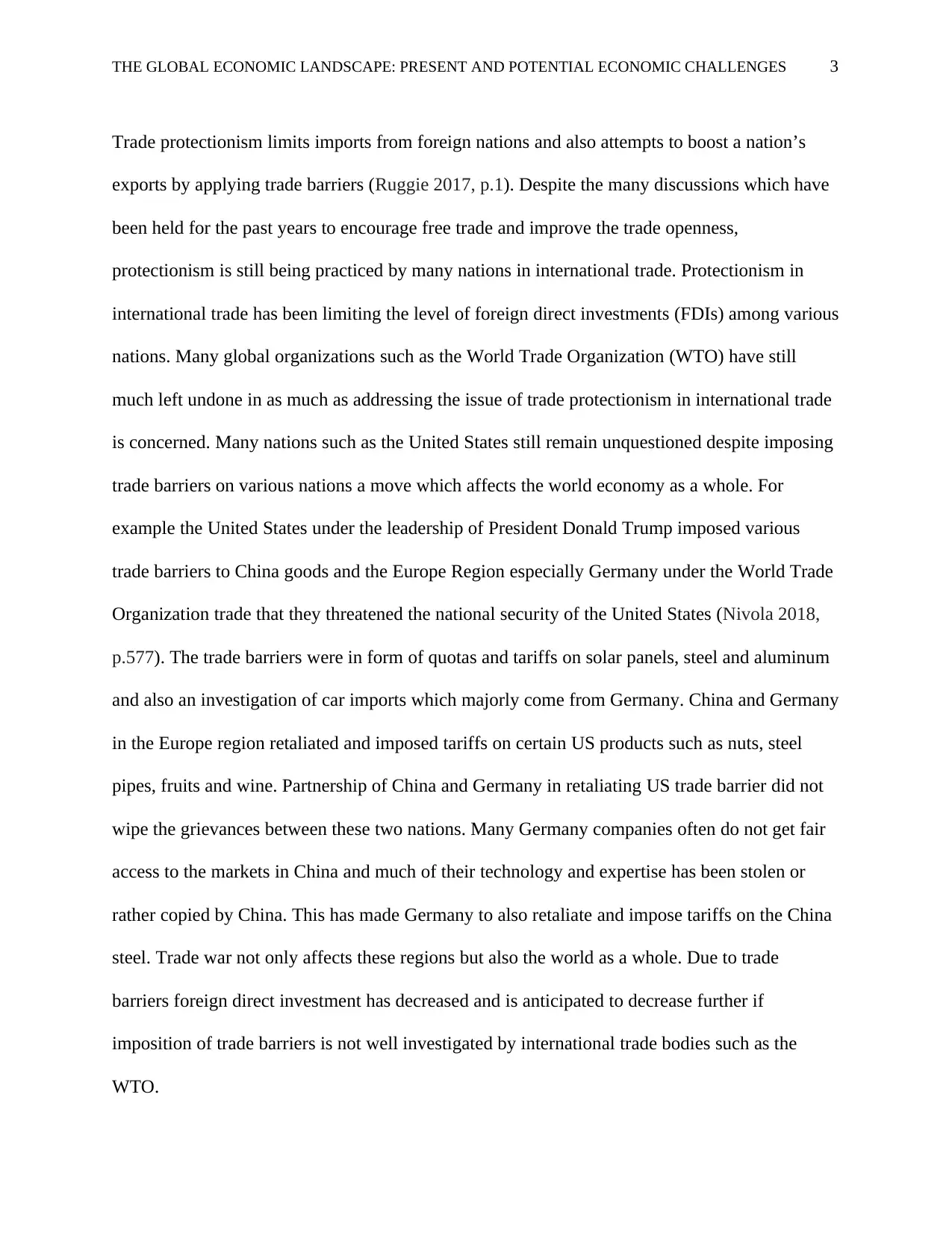
THE GLOBAL ECONOMIC LANDSCAPE: PRESENT AND POTENTIAL ECONOMIC CHALLENGES 3
Trade protectionism limits imports from foreign nations and also attempts to boost a nation’s
exports by applying trade barriers (Ruggie 2017, p.1). Despite the many discussions which have
been held for the past years to encourage free trade and improve the trade openness,
protectionism is still being practiced by many nations in international trade. Protectionism in
international trade has been limiting the level of foreign direct investments (FDIs) among various
nations. Many global organizations such as the World Trade Organization (WTO) have still
much left undone in as much as addressing the issue of trade protectionism in international trade
is concerned. Many nations such as the United States still remain unquestioned despite imposing
trade barriers on various nations a move which affects the world economy as a whole. For
example the United States under the leadership of President Donald Trump imposed various
trade barriers to China goods and the Europe Region especially Germany under the World Trade
Organization trade that they threatened the national security of the United States (Nivola 2018,
p.577). The trade barriers were in form of quotas and tariffs on solar panels, steel and aluminum
and also an investigation of car imports which majorly come from Germany. China and Germany
in the Europe region retaliated and imposed tariffs on certain US products such as nuts, steel
pipes, fruits and wine. Partnership of China and Germany in retaliating US trade barrier did not
wipe the grievances between these two nations. Many Germany companies often do not get fair
access to the markets in China and much of their technology and expertise has been stolen or
rather copied by China. This has made Germany to also retaliate and impose tariffs on the China
steel. Trade war not only affects these regions but also the world as a whole. Due to trade
barriers foreign direct investment has decreased and is anticipated to decrease further if
imposition of trade barriers is not well investigated by international trade bodies such as the
WTO.
Trade protectionism limits imports from foreign nations and also attempts to boost a nation’s
exports by applying trade barriers (Ruggie 2017, p.1). Despite the many discussions which have
been held for the past years to encourage free trade and improve the trade openness,
protectionism is still being practiced by many nations in international trade. Protectionism in
international trade has been limiting the level of foreign direct investments (FDIs) among various
nations. Many global organizations such as the World Trade Organization (WTO) have still
much left undone in as much as addressing the issue of trade protectionism in international trade
is concerned. Many nations such as the United States still remain unquestioned despite imposing
trade barriers on various nations a move which affects the world economy as a whole. For
example the United States under the leadership of President Donald Trump imposed various
trade barriers to China goods and the Europe Region especially Germany under the World Trade
Organization trade that they threatened the national security of the United States (Nivola 2018,
p.577). The trade barriers were in form of quotas and tariffs on solar panels, steel and aluminum
and also an investigation of car imports which majorly come from Germany. China and Germany
in the Europe region retaliated and imposed tariffs on certain US products such as nuts, steel
pipes, fruits and wine. Partnership of China and Germany in retaliating US trade barrier did not
wipe the grievances between these two nations. Many Germany companies often do not get fair
access to the markets in China and much of their technology and expertise has been stolen or
rather copied by China. This has made Germany to also retaliate and impose tariffs on the China
steel. Trade war not only affects these regions but also the world as a whole. Due to trade
barriers foreign direct investment has decreased and is anticipated to decrease further if
imposition of trade barriers is not well investigated by international trade bodies such as the
WTO.
⊘ This is a preview!⊘
Do you want full access?
Subscribe today to unlock all pages.

Trusted by 1+ million students worldwide
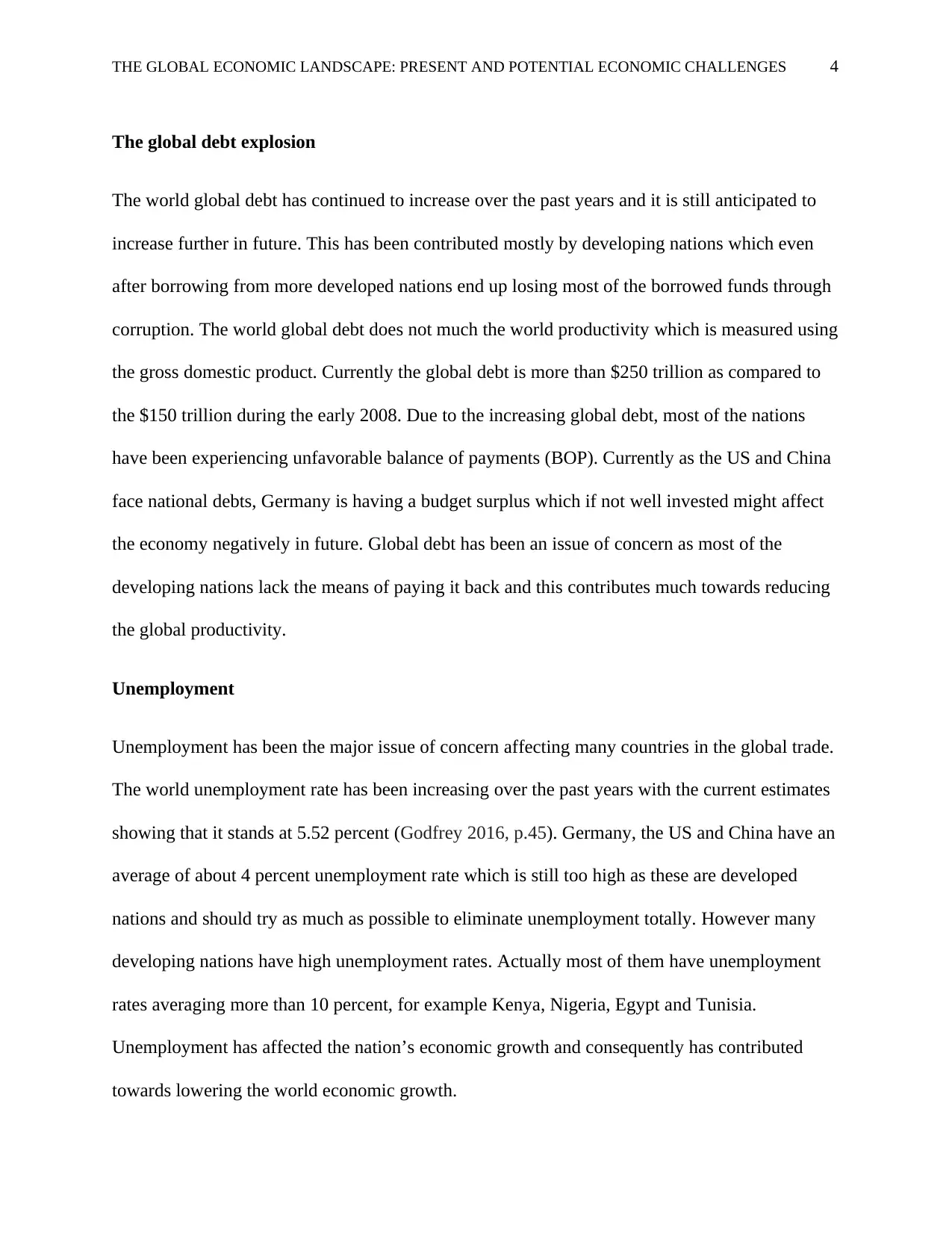
THE GLOBAL ECONOMIC LANDSCAPE: PRESENT AND POTENTIAL ECONOMIC CHALLENGES 4
The global debt explosion
The world global debt has continued to increase over the past years and it is still anticipated to
increase further in future. This has been contributed mostly by developing nations which even
after borrowing from more developed nations end up losing most of the borrowed funds through
corruption. The world global debt does not much the world productivity which is measured using
the gross domestic product. Currently the global debt is more than $250 trillion as compared to
the $150 trillion during the early 2008. Due to the increasing global debt, most of the nations
have been experiencing unfavorable balance of payments (BOP). Currently as the US and China
face national debts, Germany is having a budget surplus which if not well invested might affect
the economy negatively in future. Global debt has been an issue of concern as most of the
developing nations lack the means of paying it back and this contributes much towards reducing
the global productivity.
Unemployment
Unemployment has been the major issue of concern affecting many countries in the global trade.
The world unemployment rate has been increasing over the past years with the current estimates
showing that it stands at 5.52 percent (Godfrey 2016, p.45). Germany, the US and China have an
average of about 4 percent unemployment rate which is still too high as these are developed
nations and should try as much as possible to eliminate unemployment totally. However many
developing nations have high unemployment rates. Actually most of them have unemployment
rates averaging more than 10 percent, for example Kenya, Nigeria, Egypt and Tunisia.
Unemployment has affected the nation’s economic growth and consequently has contributed
towards lowering the world economic growth.
The global debt explosion
The world global debt has continued to increase over the past years and it is still anticipated to
increase further in future. This has been contributed mostly by developing nations which even
after borrowing from more developed nations end up losing most of the borrowed funds through
corruption. The world global debt does not much the world productivity which is measured using
the gross domestic product. Currently the global debt is more than $250 trillion as compared to
the $150 trillion during the early 2008. Due to the increasing global debt, most of the nations
have been experiencing unfavorable balance of payments (BOP). Currently as the US and China
face national debts, Germany is having a budget surplus which if not well invested might affect
the economy negatively in future. Global debt has been an issue of concern as most of the
developing nations lack the means of paying it back and this contributes much towards reducing
the global productivity.
Unemployment
Unemployment has been the major issue of concern affecting many countries in the global trade.
The world unemployment rate has been increasing over the past years with the current estimates
showing that it stands at 5.52 percent (Godfrey 2016, p.45). Germany, the US and China have an
average of about 4 percent unemployment rate which is still too high as these are developed
nations and should try as much as possible to eliminate unemployment totally. However many
developing nations have high unemployment rates. Actually most of them have unemployment
rates averaging more than 10 percent, for example Kenya, Nigeria, Egypt and Tunisia.
Unemployment has affected the nation’s economic growth and consequently has contributed
towards lowering the world economic growth.
Paraphrase This Document
Need a fresh take? Get an instant paraphrase of this document with our AI Paraphraser
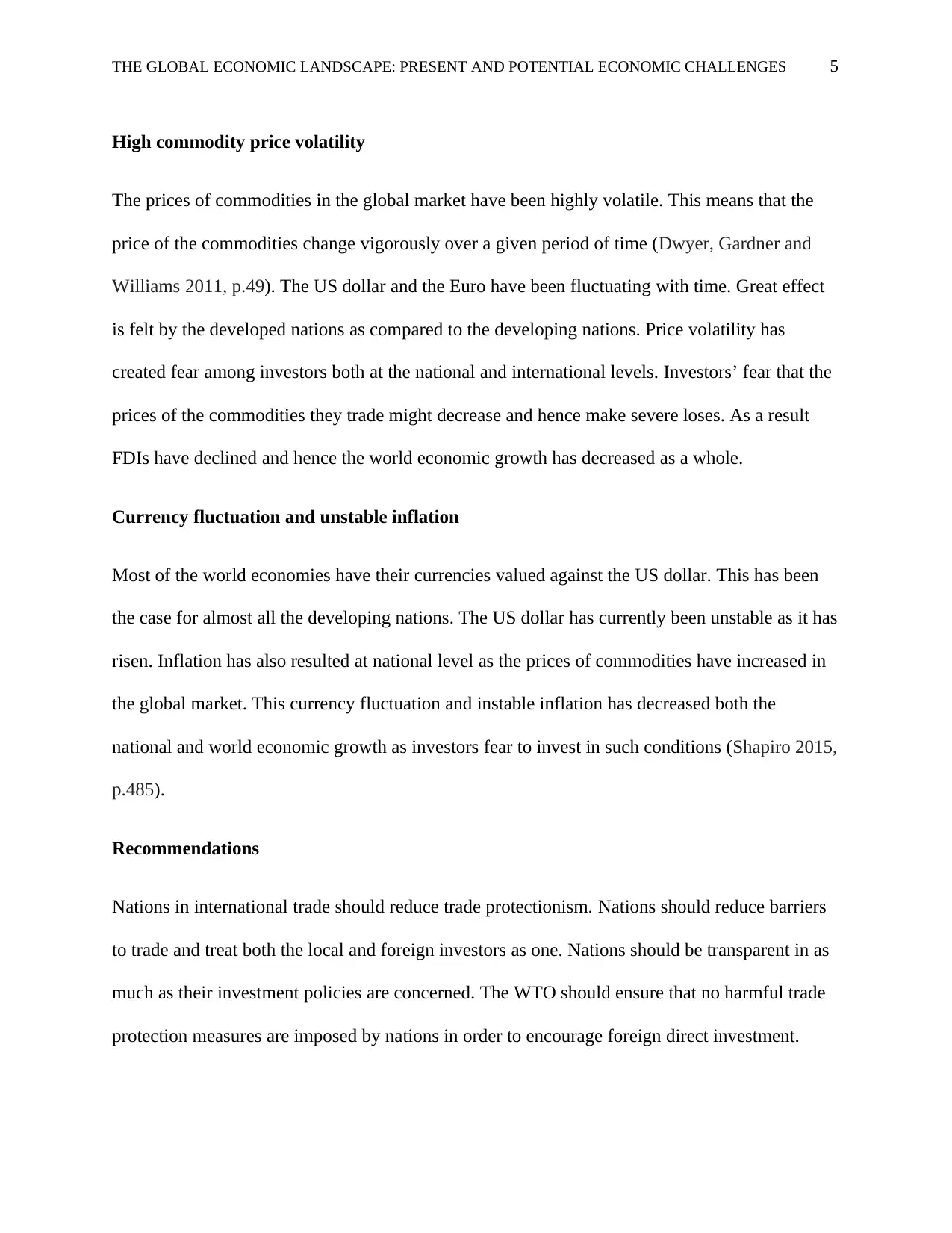
THE GLOBAL ECONOMIC LANDSCAPE: PRESENT AND POTENTIAL ECONOMIC CHALLENGES 5
High commodity price volatility
The prices of commodities in the global market have been highly volatile. This means that the
price of the commodities change vigorously over a given period of time (Dwyer, Gardner and
Williams 2011, p.49). The US dollar and the Euro have been fluctuating with time. Great effect
is felt by the developed nations as compared to the developing nations. Price volatility has
created fear among investors both at the national and international levels. Investors’ fear that the
prices of the commodities they trade might decrease and hence make severe loses. As a result
FDIs have declined and hence the world economic growth has decreased as a whole.
Currency fluctuation and unstable inflation
Most of the world economies have their currencies valued against the US dollar. This has been
the case for almost all the developing nations. The US dollar has currently been unstable as it has
risen. Inflation has also resulted at national level as the prices of commodities have increased in
the global market. This currency fluctuation and instable inflation has decreased both the
national and world economic growth as investors fear to invest in such conditions (Shapiro 2015,
p.485).
Recommendations
Nations in international trade should reduce trade protectionism. Nations should reduce barriers
to trade and treat both the local and foreign investors as one. Nations should be transparent in as
much as their investment policies are concerned. The WTO should ensure that no harmful trade
protection measures are imposed by nations in order to encourage foreign direct investment.
High commodity price volatility
The prices of commodities in the global market have been highly volatile. This means that the
price of the commodities change vigorously over a given period of time (Dwyer, Gardner and
Williams 2011, p.49). The US dollar and the Euro have been fluctuating with time. Great effect
is felt by the developed nations as compared to the developing nations. Price volatility has
created fear among investors both at the national and international levels. Investors’ fear that the
prices of the commodities they trade might decrease and hence make severe loses. As a result
FDIs have declined and hence the world economic growth has decreased as a whole.
Currency fluctuation and unstable inflation
Most of the world economies have their currencies valued against the US dollar. This has been
the case for almost all the developing nations. The US dollar has currently been unstable as it has
risen. Inflation has also resulted at national level as the prices of commodities have increased in
the global market. This currency fluctuation and instable inflation has decreased both the
national and world economic growth as investors fear to invest in such conditions (Shapiro 2015,
p.485).
Recommendations
Nations in international trade should reduce trade protectionism. Nations should reduce barriers
to trade and treat both the local and foreign investors as one. Nations should be transparent in as
much as their investment policies are concerned. The WTO should ensure that no harmful trade
protection measures are imposed by nations in order to encourage foreign direct investment.
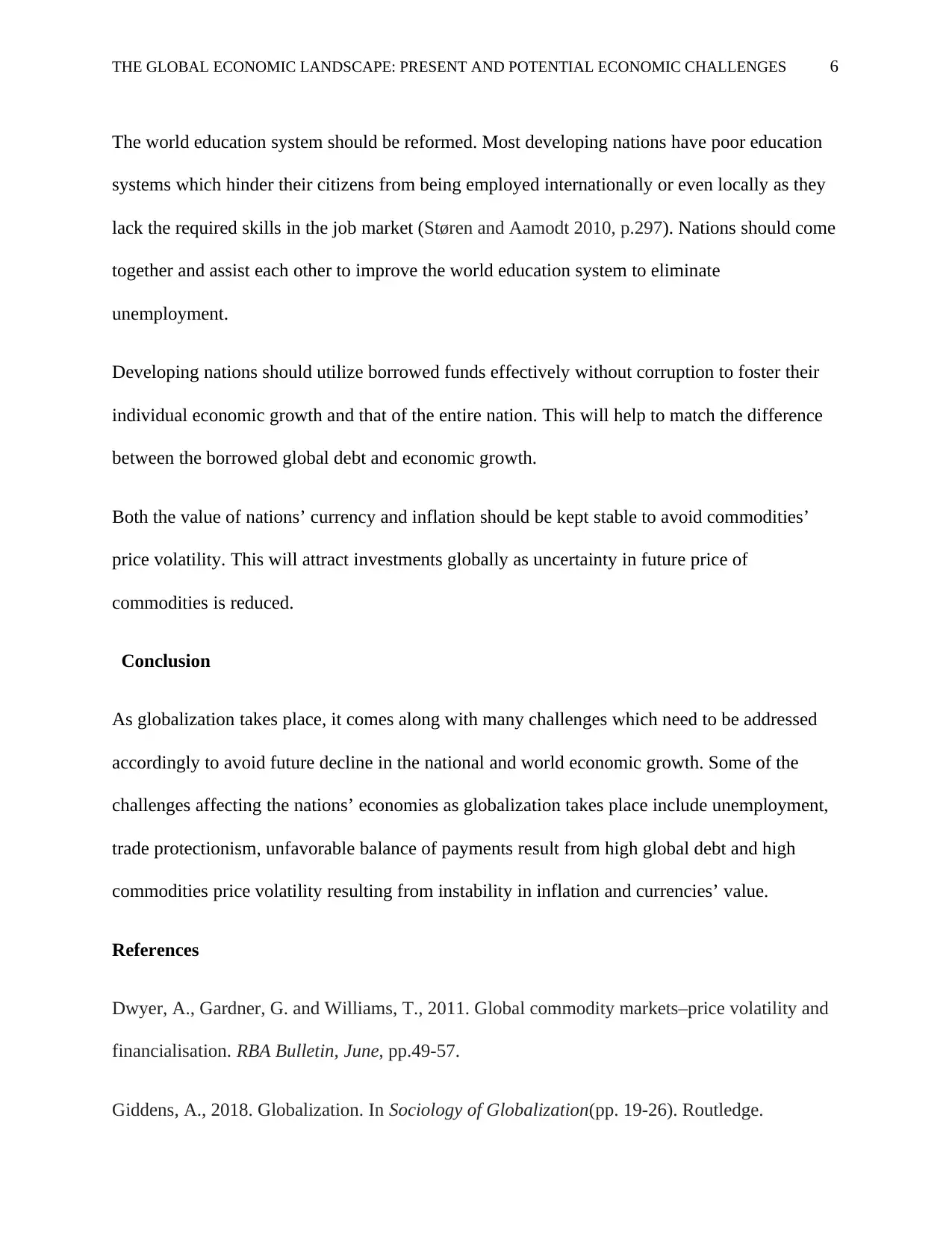
THE GLOBAL ECONOMIC LANDSCAPE: PRESENT AND POTENTIAL ECONOMIC CHALLENGES 6
The world education system should be reformed. Most developing nations have poor education
systems which hinder their citizens from being employed internationally or even locally as they
lack the required skills in the job market (Støren and Aamodt 2010, p.297). Nations should come
together and assist each other to improve the world education system to eliminate
unemployment.
Developing nations should utilize borrowed funds effectively without corruption to foster their
individual economic growth and that of the entire nation. This will help to match the difference
between the borrowed global debt and economic growth.
Both the value of nations’ currency and inflation should be kept stable to avoid commodities’
price volatility. This will attract investments globally as uncertainty in future price of
commodities is reduced.
Conclusion
As globalization takes place, it comes along with many challenges which need to be addressed
accordingly to avoid future decline in the national and world economic growth. Some of the
challenges affecting the nations’ economies as globalization takes place include unemployment,
trade protectionism, unfavorable balance of payments result from high global debt and high
commodities price volatility resulting from instability in inflation and currencies’ value.
References
Dwyer, A., Gardner, G. and Williams, T., 2011. Global commodity markets–price volatility and
financialisation. RBA Bulletin, June, pp.49-57.
Giddens, A., 2018. Globalization. In Sociology of Globalization(pp. 19-26). Routledge.
The world education system should be reformed. Most developing nations have poor education
systems which hinder their citizens from being employed internationally or even locally as they
lack the required skills in the job market (Støren and Aamodt 2010, p.297). Nations should come
together and assist each other to improve the world education system to eliminate
unemployment.
Developing nations should utilize borrowed funds effectively without corruption to foster their
individual economic growth and that of the entire nation. This will help to match the difference
between the borrowed global debt and economic growth.
Both the value of nations’ currency and inflation should be kept stable to avoid commodities’
price volatility. This will attract investments globally as uncertainty in future price of
commodities is reduced.
Conclusion
As globalization takes place, it comes along with many challenges which need to be addressed
accordingly to avoid future decline in the national and world economic growth. Some of the
challenges affecting the nations’ economies as globalization takes place include unemployment,
trade protectionism, unfavorable balance of payments result from high global debt and high
commodities price volatility resulting from instability in inflation and currencies’ value.
References
Dwyer, A., Gardner, G. and Williams, T., 2011. Global commodity markets–price volatility and
financialisation. RBA Bulletin, June, pp.49-57.
Giddens, A., 2018. Globalization. In Sociology of Globalization(pp. 19-26). Routledge.
⊘ This is a preview!⊘
Do you want full access?
Subscribe today to unlock all pages.

Trusted by 1+ million students worldwide
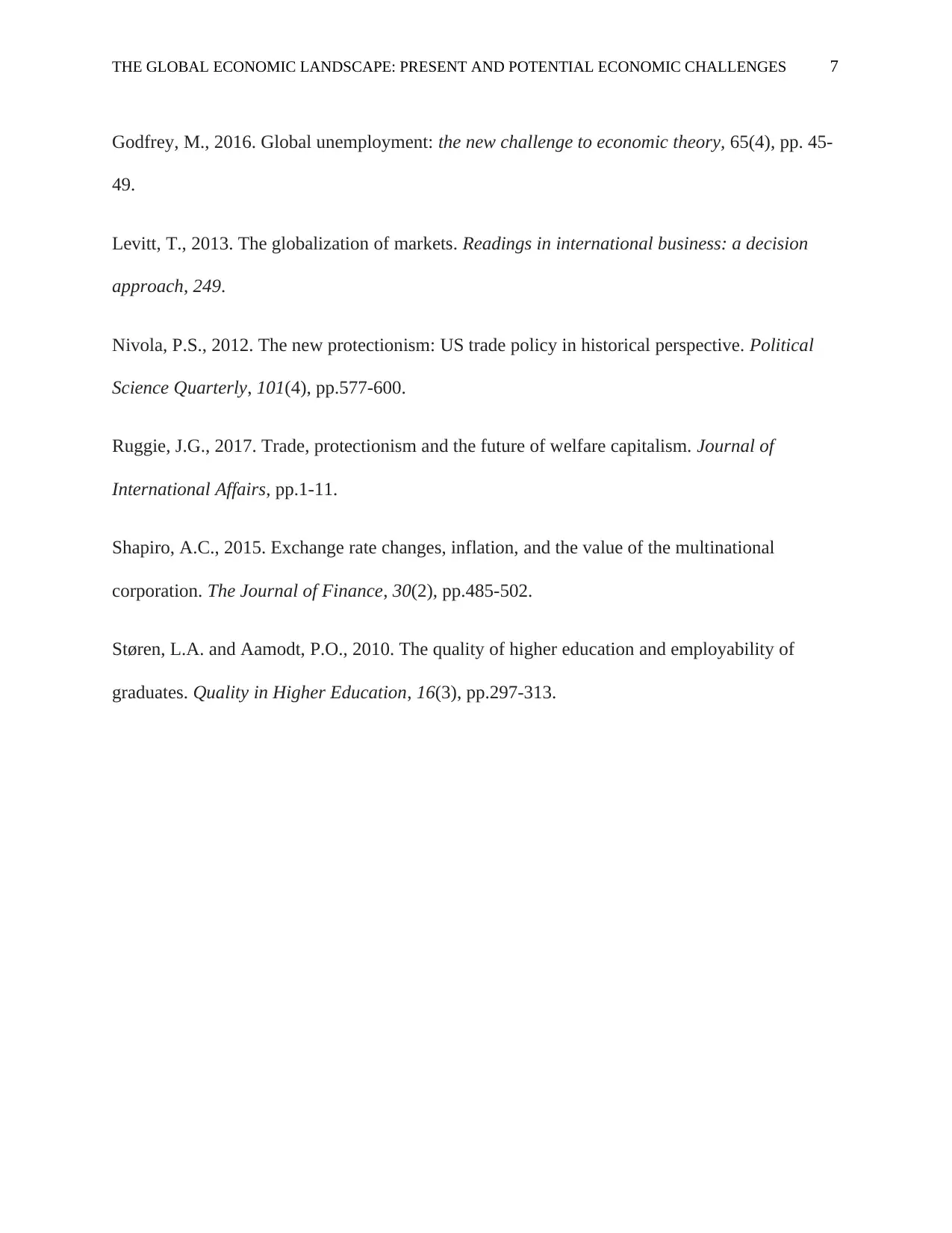
THE GLOBAL ECONOMIC LANDSCAPE: PRESENT AND POTENTIAL ECONOMIC CHALLENGES 7
Godfrey, M., 2016. Global unemployment: the new challenge to economic theory, 65(4), pp. 45-
49.
Levitt, T., 2013. The globalization of markets. Readings in international business: a decision
approach, 249.
Nivola, P.S., 2012. The new protectionism: US trade policy in historical perspective. Political
Science Quarterly, 101(4), pp.577-600.
Ruggie, J.G., 2017. Trade, protectionism and the future of welfare capitalism. Journal of
International Affairs, pp.1-11.
Shapiro, A.C., 2015. Exchange rate changes, inflation, and the value of the multinational
corporation. The Journal of Finance, 30(2), pp.485-502.
Støren, L.A. and Aamodt, P.O., 2010. The quality of higher education and employability of
graduates. Quality in Higher Education, 16(3), pp.297-313.
Godfrey, M., 2016. Global unemployment: the new challenge to economic theory, 65(4), pp. 45-
49.
Levitt, T., 2013. The globalization of markets. Readings in international business: a decision
approach, 249.
Nivola, P.S., 2012. The new protectionism: US trade policy in historical perspective. Political
Science Quarterly, 101(4), pp.577-600.
Ruggie, J.G., 2017. Trade, protectionism and the future of welfare capitalism. Journal of
International Affairs, pp.1-11.
Shapiro, A.C., 2015. Exchange rate changes, inflation, and the value of the multinational
corporation. The Journal of Finance, 30(2), pp.485-502.
Støren, L.A. and Aamodt, P.O., 2010. The quality of higher education and employability of
graduates. Quality in Higher Education, 16(3), pp.297-313.
1 out of 7
Related Documents
Your All-in-One AI-Powered Toolkit for Academic Success.
+13062052269
info@desklib.com
Available 24*7 on WhatsApp / Email
![[object Object]](/_next/static/media/star-bottom.7253800d.svg)
Unlock your academic potential
Copyright © 2020–2025 A2Z Services. All Rights Reserved. Developed and managed by ZUCOL.




